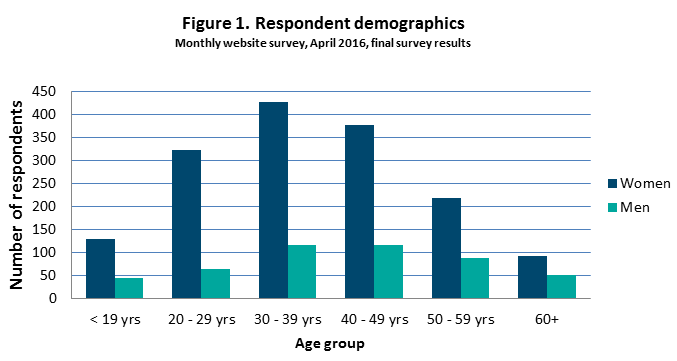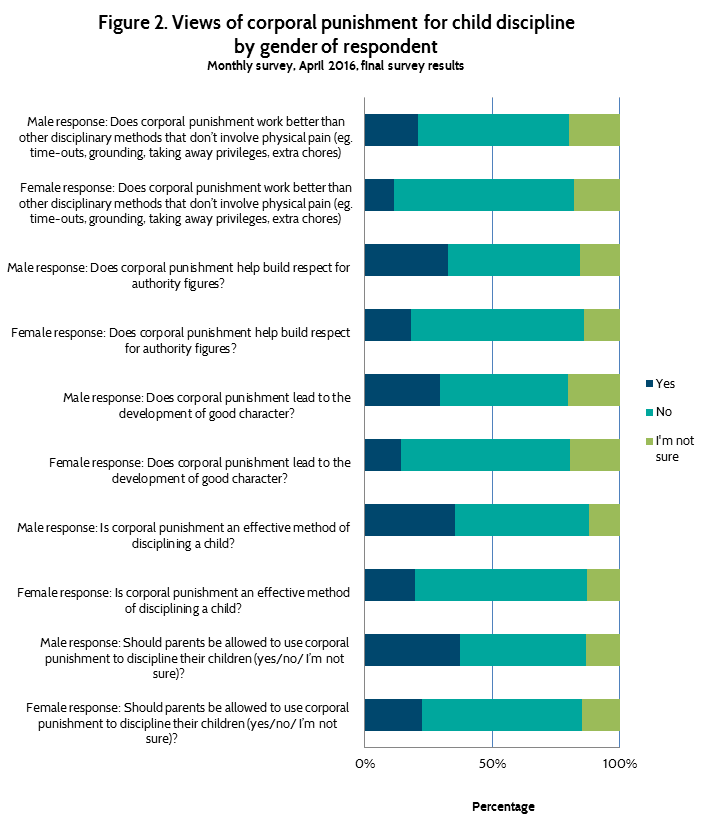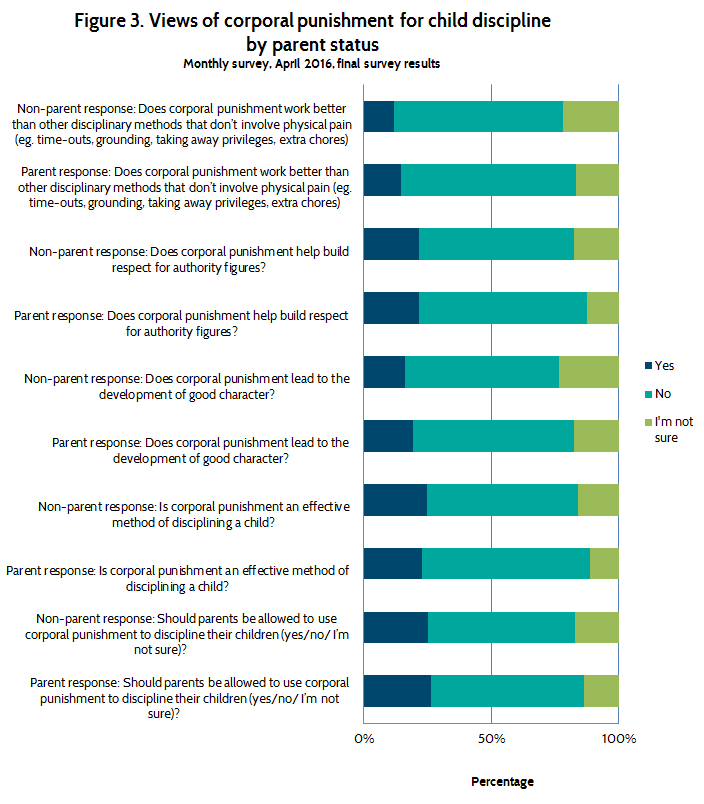Introduction
It is lawful for parents in all Australian States and Territories to use “reasonable” corporal punishment to discipline their children. The corporal punishment used by parents must be carried out for the purpose of correction, control or discipline, and it must be “reasonable” having regard to: the age of the child; the method of punishment; the child’s capacity for reasoning (for example, whether the child is able to comprehend correction/discipline); and the harm caused to the child.
Corporal punishment that results in bruising, marking or other injury lasting longer than a 24-hour period may be deemed to be “unreasonable” and can be considered as physical abuse (see CFCA Resource Sheet, March 2014).
The focus of April’s online survey was to find out how visitors to the Relationships Australia website felt about the use of corporal punishment by parents to discipline children.
Previous research finds that…
- Children aged between 3 and 5 years, and children who exhibit challenging behaviours and difficult temperaments are more likely than other children to be the recipients of corporal punishment by parents.
- Boys are more likely to experience corporal punishment than girls.
- Internationally, 37 countries have prohibited corporal punishment in all settings in legislation: Albania (2010); Austria (1989); Bulgaria (2000); Congo, Republic of (2010); Costa Rica (2008); Croatia (1998); Cyprus (1994); Denmark (1997); Finland (1983); Germany (2000); Greece (2006); Honduras (2013); Hungary (2004); Iceland (2003); Israel (2000); Kenya (2010); Latvia (1998); Liechtenstein (2008); Luxembourg (2008); Malta (2014); Netherlands (2007); New Zealand (2007); Norway (1987); Poland (2010); Portugal (2007); Republic of Moldova (2008); Romania (2004); South Sudan (2011); Spain (2007); Sweden (1979); Togo (2007); Tunisia (2010); Turkmenistan (2002); TYFR Macedonia (2013); Ukraine (2004); Uruguay (2007); and Venezuela (2007).
- Within countries that have abolished corporal punishment, the process typically began by legislating against the use of corporal punishment in schools. This was followed by the removal of the parental defence of “lawful correction” or “reasonable chastisement” from relevant criminal codes and finally the introduction of explicit bans on the use of corporal punishment in relevant civil codes.
Results
Just under 2150 people responded to the Relationships Australia online survey in April 2016. Around three‑quarters of survey respondents (76%) identified as female, with more females than males responding in every age group (see figure 1 below). Just under 90 per cent of survey respondents were aged between 20‑59 years, and just under 50 per cent of respondents comprised women aged between 30-49 years (inclusive). A higher proportion of women aged between 20 and 29 years responded to the April survey when compared to previous monthly online surveys.
As for previous surveys, the demographic profile of survey respondents remains consistent with our experience of the groups of people that would be accessing the Relationships Australia website.

Survey respondents reported significant, but minor, levels of agreement with a range of questions about the usefulness of corporal punishment in disciplining children, with a significant majority not agreeing that corporal punishment was a helpful method of disciplining children (figure 2). There were also significant differences observed between the reports of men and women.
Men (21%) were more likely than women (11%) to report that they thought that corporal punishment works in a more effective way to discipline children than other disciplinary methods that don’t involve physical pain such as time-outs, grounding, taking away privileges and extra chores, with the significant majority of survey respondents reporting that they did not consider corporal punishment more effective than other forms of discipline. Thirty-two per cent of men compared with eighteen per cent of women reported that they considered corporal punishment helped in teaching children to respect authority figures, and significant minorities of men (30%) were also more likely than women (14%) to report that corporal punishment leads to the development of good character.
When asked whether corporal punishment is an effective method of disciplining a child, only one‑third of men (33%) and women (20%) agreed. Similarly more than one-third of men (37%) and one-fifth of women (22%) reported that parents should be able to use corporal punishment to discipline their children.

In contrast to the differing responses of men and women, parents and non-parents responded similarly in their answers to each of the questions posed in the monthly survey (figure 3 below).

References
Bourke, J. P. (1981). Bourke’s criminal law: Victoria. Sydney: Butterworths.
CFCA Resource Sheet— March 2014, Corporal punishment: Key issues , available at https://aifs.gov.au/cfca/publications/corporal-punishment-key-issues
Smith, A. B., Gollop, M. M., Taylor, N. J., & Marshall, K. A. (2004). The discipline and guidance of children: A summary of research. Dunedin, NZ: Children’s Issues Centre, University of Otago and the Office of the Children’s Commissioner.
